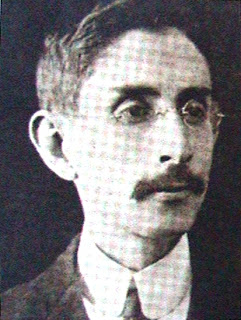Rafael Arévalo Martínez facts for kids
Quick facts for kids
Rafael Arévalo Martinez
|
|
|---|---|

Arévalo Martinez in the 1930s
|
|
| Born | 25 July 1884 Guatemala City, Guatemala |
| Died | 12 June 1975 (aged 90) |
Rafael Arévalo Martínez (born July 25, 1884, died June 12, 1975) was an important writer from Guatemala. He was born and passed away in Guatemala City.
Rafael Arévalo Martínez was many things: a writer of novels and short stories, a poet, and a diplomat. He also led Guatemala’s national library for over 20 years. Even though he is not as famous today, his short stories are still very important. One of his most famous stories is The man who resembled a horse. He also wrote a book about president Manuel Estrada Cabrera called ¡Ecce Pericles!.
He was the director of the Guatemalan National Library from 1926 to 1946. After that, he worked for a year as Guatemala’s representative in Washington, D.C.. He had different ideas from another famous Guatemalan writer, Miguel Ángel Asturias, who won the Nobel Prize. Arévalo Martínez admired the United States. But Asturias was critical of the United Fruit Company, which he felt was harming his country.
Life Story
Rafael Arévalo Martínez was a quiet child. He often got sick, but he was very talented. His mother took care of him because his father died when Rafael was only four years old. He went to Nia Chon and San José de los Infantes schools. However, he could not finish high school because of his health problems.
He worked closely with a group of artists and writers. This group included Carlos Mérida, Rafael Rodríguez Padilla, and Carlos Wyld Ospina. They also worked with Jaime Sabartés, a Spaniard who came to Guatemala in 1906. Sabartés was a close friend of the famous painter Pablo Picasso. This group was known as the "1910 generation."
Arévalo Martínez and his generation were very important for literature and art in Central America in the 20th century. They moved away from an older style called Modernism. They looked for new ways to write and create. Later, Arévalo Martínez developed his own unique writing style. Many Guatemalan writers were thankful for his advice on grammar.
Rafael Arévalo Martínez wrote both prose (like stories) and poetry. His first poem was printed in a newspaper in 1905. In 1908, he won a contest for Electra magazine with his work Woman and children. In 1911, he and Jaime Sabartés rented a house together to save money for their families.
In 1913, he helped start the magazine Juan Chapín with Francisco Fernández Hall. This magazine was a main place for the "1910 generation" to share their work. He wrote for many newspapers and magazines in Guatemala and other countries. In 1916, Arévalo Martínez lived in Tegucigalpa for a short time. He worked there as an editor for El Nuevo Tiempo. He returned to Guatemala a few months later.
Back in Guatemala, he became secretary of the Central American Office. He had already worked there editing their magazine in 1915. In 1921, he became a correspondent for the Real Academia Española. On September 15, 1922, he helped start the newspaper El Imparcial. He founded it with Alejandro Córdova, Carlos Wyld Ospina, and Porfirio Barba Jacob.
He was also the president of the "Ateneo Guatemalteco." He directed the National Library for almost twenty years. In 1945, he was named Guatemala’s delegate to the Pan American Union. He also directed the Mexican Library in Guatemala.
His Writings
Arévalo Martínez's best book of poems was Las rosas de Engaddí (1923), which means "The Roses of Engaddí." However, he is not mainly remembered for his poetry. He published two related novels about an ideal world. These were El mundo de Los Maharachías (1938) and Viaje a Ipanda (1939).
In the first novel, a man named Manuol gets shipwrecked. He finds a civilization of creatures that look like monkeys. But these creatures, called Maharachías, are smarter than humans. Their sensitive tails are almost spiritual. The second novel is more about ideas and politics.
Arévalo Martínez is most famous for his short story collection El hombre que parecía un caballo (1920). This means "The Man Who Resembled a Horse." This story was once thought to be the most famous Latin American short story of the 20th century. It was first published in 1915. The story was so popular that Arévalo tried other similar experiments. He called these "psychozoological stories." They often involved animals like a dog or a lioness. "The Man Who Resembled a Horse" is a funny story. It describes the Colombian poet Porfirio Barba Jacob as a boastful and selfish man.
List of Works
Stories and Novels
- Una vida, 1914
- El hombre que parecía un caballo, 1914
- El trovador colombiano, 1920
- El señor Monitot, 1922
- La oficina de paz de Orolandia, 1925
- El mundo de los maharachías, 1938
- Viaje a Ipanda, 1939
- Manuel Aldano, 1914 (a play)
- Ecce Pericles (a biography of Manuel Estrada Cabrera)
Poetry Collections
- Maya, 1911
- Los Atormentados, 1914
- Las rosas de Engaddi, 1927
- Por un caminito así, 1947
- "Entregate por entero", 1950
See also
 In Spanish: Rafael Arévalo Martínez para niños
In Spanish: Rafael Arévalo Martínez para niños


